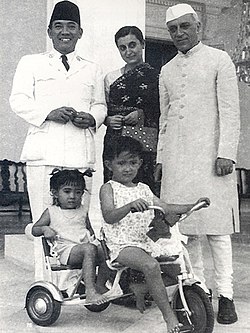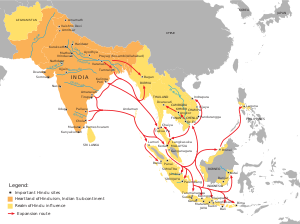India–Indonesia relations
 | |
India |
Indonesia |
|---|---|
| Diplomatic mission | |
| Embassy of India, Jakarta | Embassy of Indonesia, New Delhi |
| Envoy | |
| Indian Ambassador to Indonesia | Indonesian Ambassador to India |

India and Indonesia established diplomatic relations in 1951 (Hindi: भारत-इंडोनेशिया संबंध; Indonesian: Hubungan India-Indonesia). Both countries are neighbours, as India's Andaman and Nicobar Islands share a maritime border with Indonesia along the Andaman Sea.
The Indian-Indonesian relationship stretches back for almost two millennia. In 1950, the first President of Indonesia, Sukarno, called upon the peoples of Indonesia and India to "intensify the cordial relations" that had existed between the two countries "for more than 1000 years" before they had been "disrupted" by colonial powers.[1]
India has an embassy in Jakarta[2] and Indonesia operates an embassy in Delhi.[3] India regards Indonesia as a key member of ASEAN. Both nations had agreed to establish a strategic partnership.[4] The two countries have significant bilateral trade.[5]
India and Indonesia are among the largest democracies in the world.[6] Both are member states of the G-20, the E7 (countries), the Non-aligned Movement, and the United Nations.
According to a 2013 BBC World Service Poll, 51% of Indonesians view India's influence positively, with 21% expressing a negative view.[7]
History[]
Archaeolgy[]
South Indian origin rouletted ware at the site of Simberan, Bali has produced a carbon dating of 660 BCE (+/- 100). The population exchanges and intermarriages in the island of Bali between Indonesians and Indians was has been archaeologically dated to 2nd century BCE.[8]
Religious ties[]
The ties between Indonesia and India date back to the times of the Ramayana,[9] "Yawadvipa" (Java) is mentioned in India's earliest epic, the Ramayana. Sugriva, the chief of Rama's army dispatched his men to Yawadvipa, the island of Java, in search of Sita.[10] Indians had visited Indonesia since ancient times, and ancient Indonesian (Austronesian people) has embarked in maritime trade in Southeast Asian seas and Indian Ocean. The Ancient Indians spread Hinduism and many other aspects of Indian culture including the Sanskrit and Brahmi Script.[citation needed] The trace of Indian influences is most evident in great numbers of Sanskrit loanwords in Indonesian languages.
The name Indonesia derives from the Latin Indus, meaning "India", and the Greek nesos, meaning "island". (due to the similarity of the culture in both regions).[11] The name dates to the 18th century, far predating the formation of independent Indonesia. During the Srivijaya era, many Indonesians studied at Nalanda University in India.[12]

Indonesia entered its historical period after the adoption of Pallawa script and Sanskrit language from India as evidence in some of earliest inscriptions dated from Indonesia's oldest kingdoms such as the Yupa of Kutai, Tugu of Tarumanagara and historical records of Kalingga. Indianised Hindu-Buddhist kingdoms, such as Srivijaya, Medang, Sunda and Majapahit were the predominant governments in Indonesia, and lasted from 200[13] to the 16th century, with the last remaining being in Bali.
The Indian Epics — the Ramayana and the Mahabharata — play an important role in Indonesian culture and history, and are popular amongst Indonesians to this day. In the open theatres of the Prambanan in Java, Javanese Muslims perform the Ramayana dance during full moon nights. An example of deep Hindu-Buddhist influence in Indonesian history is 9th century Borobudur and Prambanan temples. Even after the adoption of Islam, the link between two countries remained strong; not only because India has a significant population of Muslims herself. Indonesian Islamic architecture, especially in Sumatra, has been deeply influenced by Indian Mughal architecture, evident in the Baiturrahman Grand Mosque in Aceh and Medan's Great Mosque.[citation needed]
Cultural admiration is not one-sided however, Indians also relate closely to Indonesian culture, especially Hindu Balinese culture. During his visit to Java and Bali in 1927, Rabindranath Tagore, an Indian poet, was so enamored to Bali and said "Wherever I go on the island, I see God". Then 23 years later in 1950, Pandit Jawaharlal Nehru hailed Bali as the "Morning of the World".[14]
India and Indonesia officially opened the diplomatic relations since 3 March 1951.[15] In 1955, Indian Prime Minister Jawaharlal Nehru and Indonesian President Sukarno were among the five founders of the Non-aligned Movement.
Throughout their shared history, most of relations between India and Indonesia were harmonious and peaceful, except during 1965 war with India. At that time, Indonesia offered to provide Pakistan with military help, and 'to seize Andaman and Nicobar Islands' of India so as to distract it from the Kashmir front, eventually mobilising submarines to help Pakistan. A maritime boundary agreement between the two countries was issued in New Delhi on 14 January 1977.[16]
President of Indonesia Sukarno was the first chief guest at the annual Republic Day parade of India in 1950. In the year 2011, President Susilo Bambang Yudhoyono was the chief guest for the same event.[6]

Borobudur, a Buddhist Temple built by Sailendra dynasty, the temple's design in Gupta architecture reflects India's influence on the region.[17]

The Prambanan Temple of Central Java, reflecting Hindu architectural influences.[18]

The Balinese script in a Hindu temple. Indian introduced the first form of writing to Indonesia, which evolved into the writing scripts still used in Bali and Java.[19]
Idli, an Indian savoury cake from South India.

Roti canai, an Indian-influenced flatbread found in Indonesia.
Strategic partnership[]

India and Indonesia, united by historic cultural ties, have signed strategic partnership agreement to enhance cooperation in the national and maritime security and safety, trade connectivity, infrastructure and economic development. India's southernmost territory of Andaman and Nicobar Islands lies close to Aceh province of Indonesia, an area which is an important global trade route. In May 2018, "Shared Vision of Maritime Cooperation in the Indo Pacific" agreement was signed when Indian Prime Minister Narendra Modi visited Indonesia. Subsequently, Indian Navy and Indonesian Navy have been hosting bilateral "Samudra Shakti" naval exercise since November 2018 including in Java Sea and Andaman Sea. These exercises are an significant enhancement of operational engagement between these two navies after their 2002 "Ind-Indo Corpat" agreement. India and Indonesia are also jointly developing Sabang Deep sea Port, and Indian naval ships have been regularly visiting this port after the signing of the agreement. Several Indian navy ships undertook naval exercises and visits to Indonesia e.g. a destroyer INS Rana in 2002, INS Sumitra in July 2018, INS VIJIT in 2019.[20]
Economic relations[]
On 25 January 2011, after talks by Indian Prime Minister Manmohan Singh and visiting President of Indonesia Susilo Bambang Yudhoyono, India and Indonesia had signed business deals worth billions of dollars and set an ambitious target of doubling trade over the next five years.[21]
India also has further economic ties with Indonesia through its free trade agreement with ASEAN, of which Indonesia is a member.[22]
The two countries target to achieve bilateral trade of $25 billion by 2015, with cumulative Indian investments of $20 billion in Indonesia.[5]
Culture[]

Historically, Indonesian archipelago was heavily influenced by dharmic civilization of India. For example, Ramayana is a major theme in Indonesian dance drama traditions, especially in Java and Bali.
The cultural ties still continue, with popular Indonesian Dangdut music displaying the influence of Hindustani musics very popular within the people of Indonesia especially middle-class to lower-class people that enjoy the tabla-beat music. Bollywood films and music are also popular in Indonesia.[23] To promote Indian culture in Indonesia, the Jawaharlal Nehru Indian Cultural Centre was established in Jakarta in 1989, featuring a library and providing lessons on Indian culture, as well as promoting art such as Yoga, Indian music and dance.[24]
See also[]
- Indian Indonesians
- Ramayana
- Mahabharata
- List of institutions with Sanskrit mottos
Further reading[]
- Hoadley, M. C. (1991). Sanskritic continuity in Southeast Asia: The ṣaḍātatāyī and aṣṭacora in Javanese law. Delhi: Aditya Prakashan.
- Hughes-Freeland, F. (1991). Javanese visual performance and the Indian mystique. Delhi: Aditya Prakashan.
- Lokesh, Chandra, & International Academy of Indian Culture. (2000). Society and culture of Southeast Asia: Continuities and changes. New Delhi: International Academy of Indian Culture and Aditya Prakashan.
- Cœdès, George (1968). Walter F. Vella (ed.). The Indianized States of Southeast Asia. trans.Susan Brown Cowing. University of Hawaii Press. ISBN 978-0-8248-0368-1.
- R. C. Majumdar, Study of Sanskrit in South-East Asia
- R. C. Majumdar, Champa, Ancient Indian Colonies in the Far East, Vol.I, Lahore, 1927. ISBN 0-8364-2802-1
- R. C. Majumdar, Suvarnadvipa, Ancient Indian Colonies in the Far East, Vol.II, Calcutta,
- R. C. Majumdar, Kambuja Desa Or An Ancient Hindu Colony In Cambodia, Madras, 1944
- R. C. Majumdar, Hindu Colonies in the Far East, Calcutta, 1944, ISBN 99910-0-001-1
- R. C. Majumdar, India and South-East Asia, I.S.P.Q.S. History and Archaeology Series Vol. 6, 1979, ISBN 81-7018-046-5.
- R. C. Majumdar, Ancient Indian colonisation in South-East Asia; History of the Hindu Colonization and Hindu Culture in South-East Asia
- Daigorō Chihara (1996). Hindu-Buddhist Architecture in Southeast Asia. BRILL. ISBN 90-04-10512-3.
- The journey of the Goddess Durga: India, Java and Bali by Ariati, Ni Wayan Pasek, 2016, ISBN 9788177421521, Aditya Prakashan, New Delhi
References[]
- ^ Foreign Policy of India: Text of Documents 1947-59 (p.54)
- ^ http://www.embassyofindiajakarta.org/
- ^ "Archived copy". Archived from the original on 21 October 2008. Retrieved 14 September 2008.CS1 maint: archived copy as title (link)
- ^ Getting closer to Indonesia
- ^ Jump up to: a b "Indian pushes for early economic accord with Indonesia". IANS. news.biharprabha.com. 24 April 2014. Retrieved 24 April 2014.
- ^ Jump up to: a b Ram Bahukhandi (27 January 2011). "Letter: India and Indonesia – Natural allies". The Jakarta Post. Retrieved 14 May 2015.
- ^ 2013 World Service Poll BBC
- ^ Bali in the world of Buddhism
- ^ Ramayana to Bollywood, Indonesia Loves India
- ^ History of Ancient India Kapur, Kamlesh
- ^ Tomascik, T.; Mah, J.A.; Nontji, A.; Moosa, M.K. (1996). The Ecology of the Indonesian Seas - Part One. Hong Kong: Periplus Editions Ltd. ISBN 962-593-078-7.
- ^ "Archived copy" (PDF). Archived from the original (PDF) on 19 August 2011. Retrieved 3 March 2011.CS1 maint: archived copy as title (link)
- ^ "Archived copy". Archived from the original on 21 February 2015. Retrieved 21 February 2015.CS1 maint: archived copy as title (link)
- ^ "History". Bali India Foundation. Archived from the original on 18 May 2015. Retrieved 14 May 2015.
- ^ RI-India Perluas Kerjasama Ekonomi, Energi dan Hukum Antara News
- ^ "India-Indonesia Maritime Boundary Agreement" (PDF). Foreign Affairs Record. XXIII (1): 2. January 1977. Retrieved 6 August 2013.
- ^ "Borobudur : A Wonder of Indonesia History". Indonesia Travel. Archived from the original on 14 April 2012. Retrieved 5 April 2012.
- ^ K.A. Nilakanta Sastri, A History of South India, pp 424–426
- ^ "Balinese alphabet, language and pronunciation".
- ^ Eyeing Southeast Asia, India builds port in Indonesia, Economic Times, 20 May 2019.
- ^ "India and Indonesia aim to double trade". BBC News. 25 January 2011.
- ^ "India and Asean aim to boost trade". BBC News. 3 March 2011.
- ^ Ashwini Devare (16 November 2011). "Neighbourly warmth infuses Indonesia-India relations". IBN Live. Archived from the original on 19 November 2011. Retrieved 16 November 2011.
- ^ "Jakarta's Indian Cultural Centre on the Move". Archived from the original on 23 September 2012. Retrieved 13 April 2011.
Further reading[]
- Van Leeuwen, Bas. Human capital and economic growth in India, Indonesia, and Japan: a quantitative analysis, 1890-2000 (Box Press, 2007).
External links[]
| Wikimedia Commons has media related to Relations of India and Indonesia. |
- India–Indonesia relations
- Bilateral relations of Indonesia
- Bilateral relations of India




